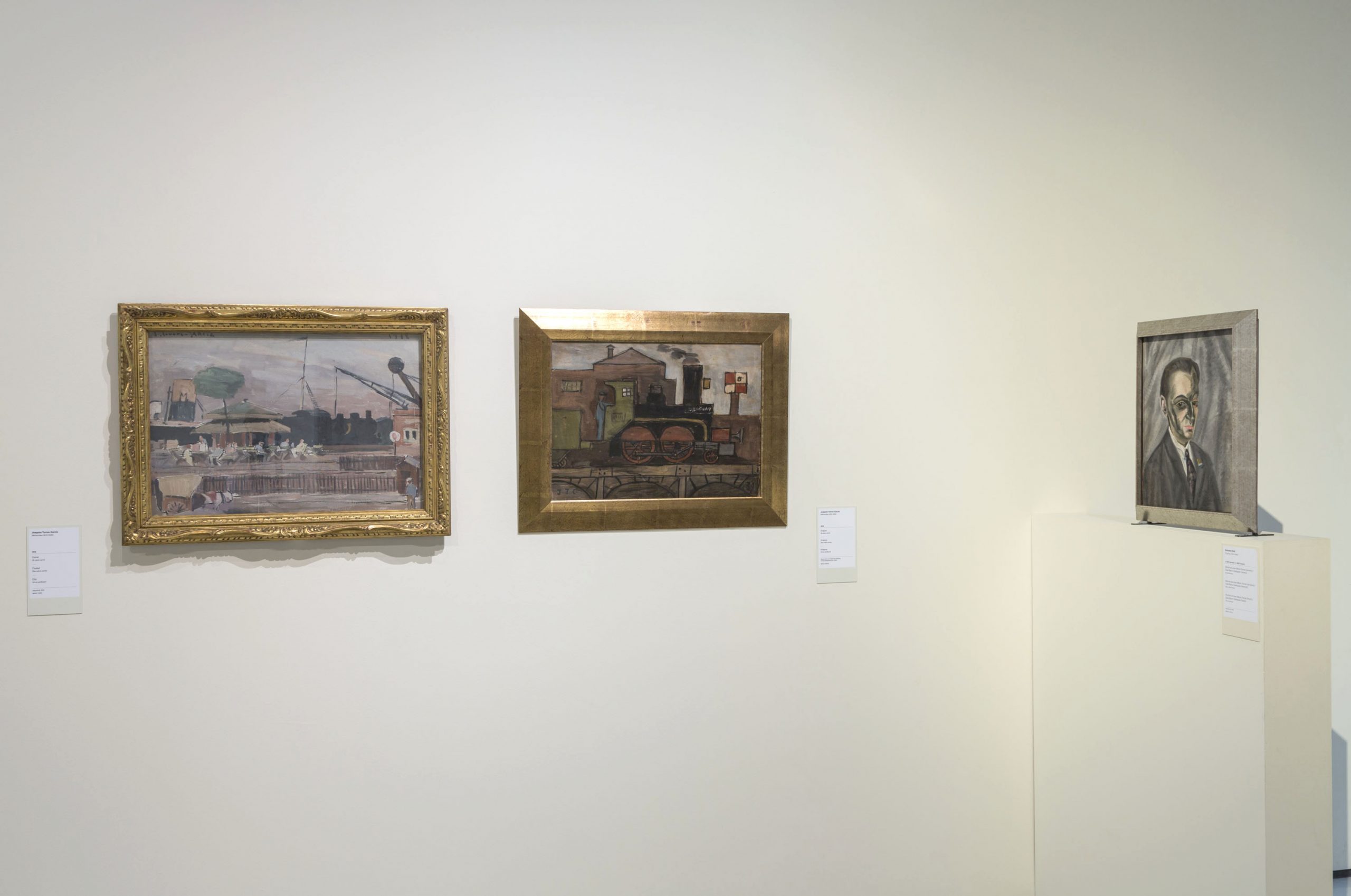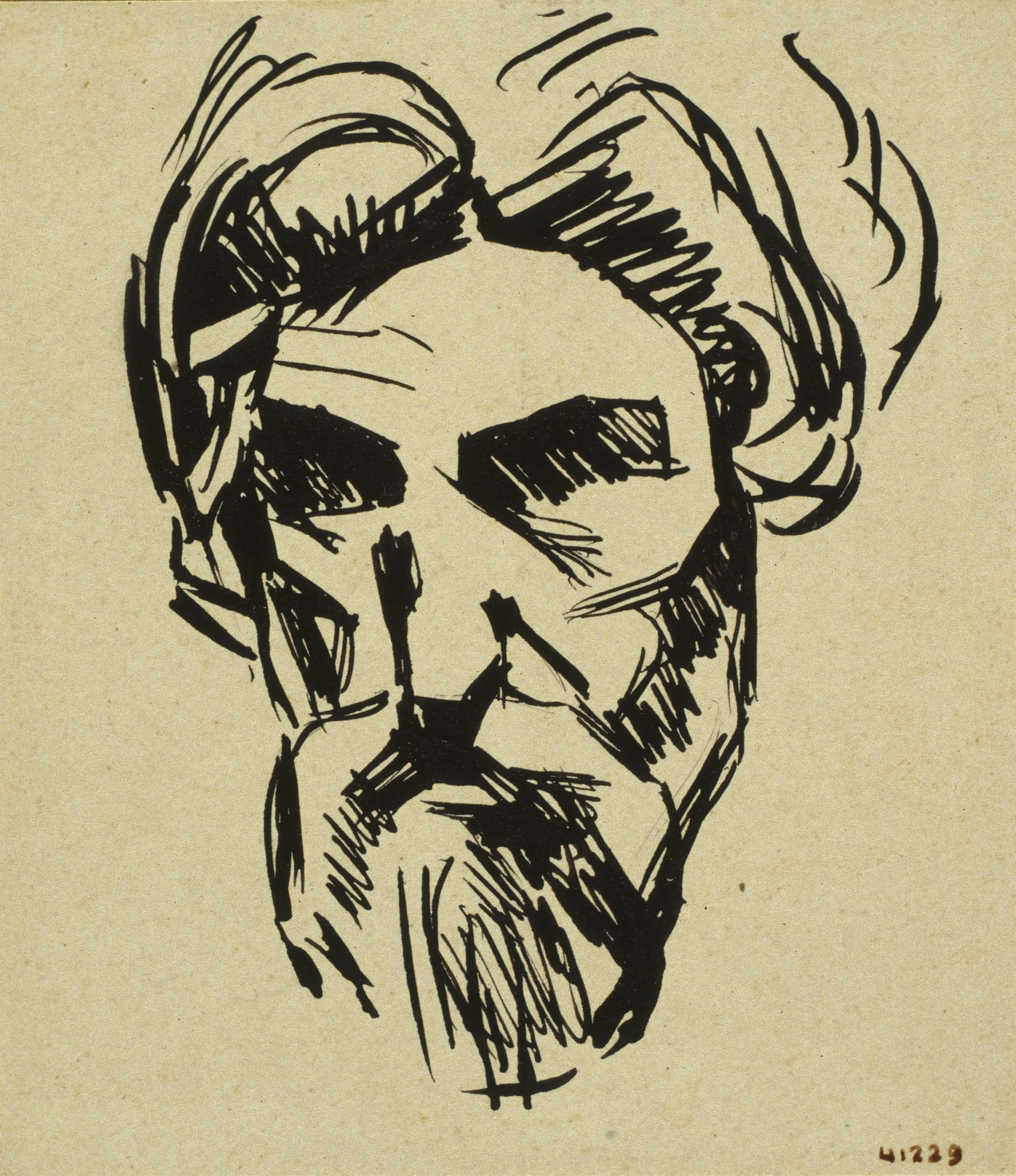Eduard Vallès
This text is the continuation of the previous blogpost, which deals with the collection of works by the artist Joaquim Torres-García in the Museu Nacional. This year sees the 130th anniversary of the Uruguayan artist’s arrival in Barcelona and his settling down in the city where he lived – and trained as an artist – for almost three decades. The text summarily analyses the works by Torres Garcia in chronological order with the aim of establishing a correlation with his life. Part one referred to his beginnings as an artist in Barcelona belonging to the period of training under the aegis of Modernisme and after that his neoclassical period was analysed. The second and final part of the text follows below.

Works by Joaquim Torres-García at the Modern Art 70 room in Museu Nacional.
Decorative programmes destroyed and cut short
A religious composition dating from 1908 is an indirect testimony to fresco painting. It is a sketch in oils that he made as a result of the commission he was given to decorate the chapel of the Holy Sacrament in the church of Sant Agustí, in the Raval neighbourhood of Barcelona, six large paintings in all.

Joaquim Torres-García. Project of the mural decoration of the chapel of the Holy Sacrament in the church of Sant Agustí. 1908. Oil on canvas. 36,5 x 70 cm
Unfortunately, like so many religious paintings this group was destroyed in 1936 at the start of the Spanish Civil War. Thanks to this sketch, several photographs, and the artist’s testimony, we have an idea of the group and we know, for example, that the paintings followed processional models and depicted scenes such as the institution of the Eucharist or Viaticum, in which a self-portrait of the artist even appeared in one of the compositions. A curious aspect of this work is the dedication, to Enric Prat de la Riba no less, who, as president of the Mancomunitat de Catalunya, commissioned him to decorate the Saló Sant Jordi in the Palace of the Generalitat: “A D. Enrich Prat de la Riba / Cordialment / J. Torres García”. This work is a long-term loan by the Generalitat from the Prat de la Riba Aymamí dation (2000).
From 1913 he worked on those murals in the Saló Sant Jordi according to a decorative programme to which Torres gave a great deal of thought and worked on very much, but the project was cut short as a consequence of Prat de la Riba’s death in 1917. The following year his successor, Puig i Cadafalch, decided to call a halt to the project that had occupied the artist for approximately five years, something that caused him to have a nervous breakdown. Dating precisely from that time, towards the end of the 1910s, is another pair of works in the museum’s collections. One of these is the only self-portrait in the collection, an ink on paper from about 1917 in the Cabinet of Drawings and Prints, also from the Rossend Partagàs Bequest (1945). In this schematic ink portrait we see a visibly aged Torres, a circumstance that cannot be dissociated from the massive shock that had hit him very hard.

Joaquim Torres-García. Self-portrait. Circa 1917. Pen and ink on paper. 8,7×7,6cm
From rural order to the industrial city
But the most important work is City, an oil on cardboard that was acquired that same year, 1918. This work belongs to a key moment in his career, in which he turned towards the Avant-garde, more in keeping with the most modern contemporary ideas. His work evolved from classical visual codes – generally rural and Arcadian – towards other openly urban and industrial ones. The city as a dynamic, changing place became the motif of his creations and in this painting he depicted the port of Barcelona from the front with several scenes taking place at the same time but in the same space, still lacking the boldness of the simultaneous fragmented images we would later also see in his work.

Joaquim Torres-García. City. Circa 1918. Oil on cardboard. 52 x 72,2 cm
All the works seen so far have as the common denominator the fact that they were made in Catalonia, where he lived for approximately half of his artistic career. The last three pieces belong to later periods, and at the same time also they correspond to registers completely different from one another. From the mid 1920s we have the wood painting Architectural Construction with Figures, a work on loan, since 2004, from the Carmen Thyssen-Bornemisza Collection. It is the only wood painting by this artist exhibited in the rooms of the museum, where it replicates with a new material – wood – the classical models that characterized his work at the beginning of the twentieth century. In this case, it is in tempera on wood, another aspect that makes this piece unusual.

Joaquim Torres-García. Architectural construction with figures. 1925 or first half of 1926. Tempera on wood. 50x 52cm.
From approximately the same period is the oil painting Spanish Woman, on loan from the Generalitat, originally from the Riera Collection (1995). It is a dark painting, along the lines of many portraits that he did in his mature period, normally of black and brown hues, often depicting deformed or long faces, or compositions with Primitivist echoes. In this case, it is a female figure with folkloric accessories, a fan and a mantilla, an iconography not too habitual in Torres’s work.

Joaquim Torres-García. Spanish Woman 1926. Oil on canvas. 46x56cm.
The latest work in the collection is a painting from 1939 that was made in Uruguay, where Torres had returned in 1934, and where he was welcomed with full honours and treated as an authentic institution. The work is in the National Art Collection – on loan from the Generalitat de Catalunya (1995) – and it shows a train on a bridge, with his classic fragmentation and great chromatic power. The title of the work, very eloquent, stands out in white on the black of the locomotive: Uruguay. Torres-Garcia’s train was coming to the end of the line, and it was in this country where he died in 1949, just ten years after making this painting.

Joaquim Torres-García. Uruguay. 1939. Oil on canvas. 46,6x64cm.
Art modern i contemporani







